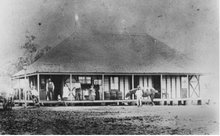According to a heritage workbook published by the Rosewood Scrub Historical Society, migration was all about land. It argues that most Europeans had no chance of ever owning land in Europe and were attracted to the readily available land in the colonies. I wondered if this was universally the case so I read a bit further. It appears that there were different eras of migration from Germany in the nineteenth century.
In fact there were three main waves of migration in this time. The first wave was from 1845-1858 and peaked in 1854 with 250,000 migrants that year alone. The second wave was from 1864-1873 and totalled one million. The third wave of migration was 1880-1885, totalling 860,000 with a quarter of those leaving in 1881.
According to Blackbourn, the first wave of migration was religious and political – old Lutherans to new colonies, Swabian Pietists to Russia, various Catholic groups to the United States. Political migrants were socialist radicals and others who lost out in the failed 1848 revolution. Economic migrants in the first wave were small peasants and craftsmen from overpopulated rural areas in the southwest of Germany. These migrants usually migrated as family groups prepared to settle in the new land. These are the types of people who would have made their way to the Rosewood Scrub.
The second wave of migration was also due to rural overpopulation, but in this case mainly in the west. From the 1860s onwards, migration sources shifted to the east and northeast with most of the migrants being single agricultural labourers and factory workers.
These migrants on arrival in Australia would most likely congregate in larger cities where labouring jobs were available rather than to settle in rural areas. I have read stories though of single male workers in the German work camps in Brisbane coming out to the towns of the Rosewood Scrub for social and church functions. It was a chance to speak German and perhaps meet a nice girl. Many of the family history books record marriages in Australia to fellow migrants or children of migrants. Many of the marriages were second or third marriages. Life wasn’t easy and having a partner was essential to survival in a new land.
Subscribe to:
Post Comments (Atom)

No comments:
Post a Comment